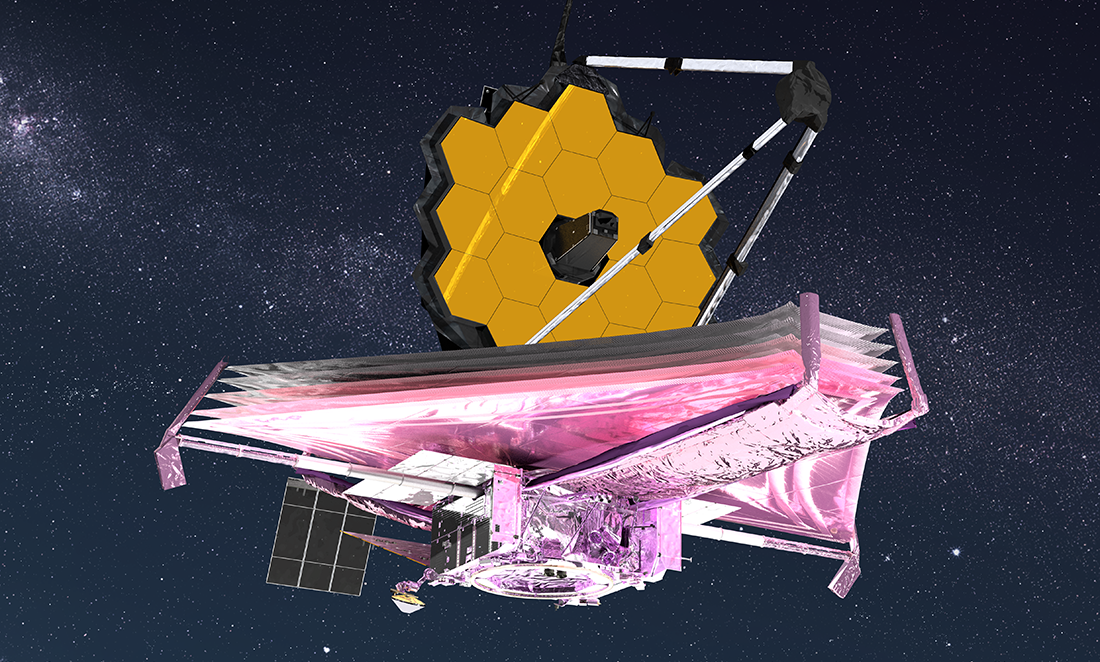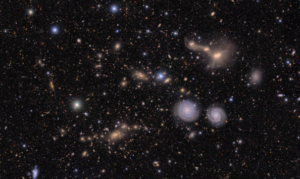Talking Heads once famously posited: “And you may ask yourself, ‘Well, how did I get here?'”
It’s an age-old question astronomers have been searching for answers to for decades. And by searching, we mean really searching. Peering high and low throughout seemingly endless expanses of space. Examining countless stars, planets, galaxies and everything in between.
Remember, it’s a universe that’s alive and dynamic. Clouds of gas and dust birth new stars, disks of debris form new planets. Even galaxies collide from time to time.
To take a closer look, astronomers build the biggest and best telescopes they can – and there’s a new one on the block.
Seeing things for the first time
Easily the most well-known telescope is the Hubble Space Telescope.

Named after astronomer Edwin Hubble, NASA launched it into low-Earth orbit back in 1990. Since then, Hubble has revealed a universe of previously unimaginable size and beauty.
Over the past 30-plus years, Hubble has seen a lot. It’s watched clouds of dust and gas inside the Milky Way collapse under their own weight to form new stars. It’s peered into the inky depths of the space, revealing that the universe is filled with hundreds of billions of galaxies. It’s led to breakthroughs in astrophysics and captured some of the most detailed images of deep space.
But there’s a drawback. Hubble’s vision is limited in the way our eyes are. We can’t see through dust clouds – neither can Hubble. Moreover, the expanding universe stretches out incoming light from the most distant galaxies, a process called redshift, moving them out of Hubble’s visible range into the infrared part of the spectrum. They’re still there, but their light is stretched out so much that Hubble can’t see them.
A clearer view
Hubble is an optical telescope. It sees the same light your eyes do. To see through dust clouds to the newly forming stars and planets within and to see distant redshifted galaxies way across the universe, you need an infrared telescope.

Infrared light is a lower energy light that's invisible to the human eye. Our bodies can still detect it – we feel it as heat.
If you’ve ever seen a night vision image, it was taken using an infrared camera.
Infrared light passes through dust, so an infrared camera can see through the dust that obscures Hubble’s view. Moreover, when starlight from distant galaxies is redshifted, it moves into the infrared part of the spectrum. An infrared or telescope is exactly what you need to see them.
In search of the end of darkness
NASA (in partnership with the European and Canadian Space Agencies) has been developing a successor to the legendary Hubble since 1996.
Weighing more than 6 tonnes and costing US$10 billion, the James Webb Space Telescope (Webb) is named after a former NASA director.

Webb is an infrared telescope designed to probe the deepest, darkest and oldest corners of the universe. Webb will be able to see farther into space and deeper into its past.
Webb will be able to examine the most-distant galaxies from a time when the universe was very young – about 13.5 billion years ago.
These observations will reveal clues to how the Milky Way came to be.
In the search for humanity’s origins, we need to understand how Earth-like planets are formed. It is hoped Webb will guide the way and bring us closer to answering the eternal question of where we came from. (It’ll also keep a keen eye out for signs of life.)
A long-awaited, nail-biting ascent
The long-awaited Webb has been plagued by setbacks, budget blowouts and delays. During one prelaunch test, the insulating sunshield tore, which set the project back an entire year. More recently, a belt on the launch adaptor sprang loose, causing unplanned-for vibration. (And that’s without mentioning any pandemic-related delays.)
Now, the countdown is on. Webb is scheduled to lift off at 8.20pm AWST on 25 December – but be aware it has been delayed multiple times already so double check this time closer to the day. Riding atop an Ariane 5 rocket, it will launch from the European Spaceport in French Guiana, South America.
After launching, it will deploy and embark on a 30-day journey to the second Lagrange point, known as L-2. This point is 1.5 million kilometres away from Earth – about four times farther away from us than the Moon. Instead of orbiting Earth, like Hubble does, it will orbit the Sun from this point in space.
To infinity and beyond!
The Hubble Space Telescope’s discoveries have had a profound impact on our understanding of the universe and our place within it.
What secrets will the James Webb Space Telescope unveil about the cosmos? Only time will tell.











